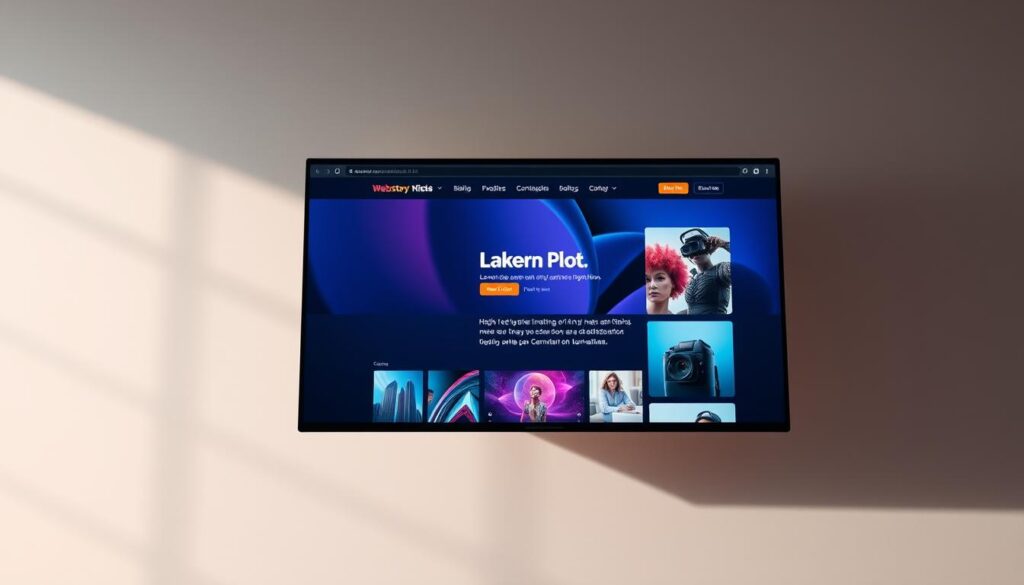Have you ever wondered why some websites attract more visitors while others struggle to keep their audience engaged? The answer lies in the power of visual storytelling. Web Stories, a dynamic content format, are transforming how users interact with online platforms.
Combining video, audio, images, and text, this format offers a mobile-first, swipe-friendly experience. It’s designed to captivate users and keep them coming back for more. With case studies showing up to 18x growth in traffic and 17x higher AdSense revenue, it’s clear why this format is gaining popularity.
Google Search and Discover also prioritize Web Stories, making them highly visible in regions like the US, India, and Brazil. This visibility, paired with seamless AdSense integration, opens up new monetization opportunities for creators and businesses alike.
Key Takeaways
- Web Stories combine video, audio, images, and text for a rich user experience.
- They can boost traffic by up to 18x and increase AdSense revenue by 17x.
- Google Search and Discover prioritize this format, enhancing visibility.
- The mobile-first design is swipe-friendly and highly engaging.
- AdSense integration offers effective monetization strategies.
What Are Web Stories and Why Are They Important?
Visual storytelling is reshaping how users interact with online platforms. Web Stories, powered by AMP, are full-screen, tap-through narratives that blend video, audio, and images. This format is designed for mobile-first experiences, similar to Instagram Reels and YouTube Shorts.
One of the biggest advantages of this format is its visibility in Google Discover. Case studies show that 92% of website traffic from the Discover section has a 10x higher CTR compared to traditional search results. This makes it a powerful tool for driving engagement.
Understanding the Web Stories Format
These visual narratives are built with AMP compliance, ensuring they are eligible for indexing and Discover placement. The horizontal swipe behavior keeps users engaged, while full-screen ad placements offer mindshare benefits for creators.
Benefits of Using Web Stories for Traffic
Strategic implementation can lead to an 18x growth in page views. Additionally, they provide link-building opportunities to long-form content or products, enhancing overall website performance. By leveraging this format, creators can maximize visibility and user stickiness.
How to Create a Web Story
Mastering the art of visual narratives can significantly boost your online presence. Creating a compelling visual story involves selecting the right tools, optimizing multimedia elements, and ensuring AMP compliance. This section will guide you through the essential steps to craft an engaging and effective visual narrative.
Choosing the Right Story Editor Tool
When it comes to creating a visual narrative, the choice of editor is crucial. No-code editors like MakeStories and Newsroom AI offer user-friendly interfaces, making it easy for beginners to get started. For those with technical expertise, custom AMP development provides more flexibility and control. Both paths have their advantages, so choose based on your skill level and project requirements.

Incorporating Multimedia Elements
Multimedia elements are the backbone of any visual narrative. Images should be optimized for portrait orientation, with a resolution of 720×1280 pixels. Videos, on the other hand, should maintain a 16:9 aspect ratio. Using Chrome Developer Tools can help simulate different devices, ensuring your content looks great on all screens.
Ensuring AMP Compliance
AMP compliance is essential for your visual narrative to be eligible for Google Search and Discover. Use validation tools like the Web Stories Google Test Tool and AMP Linter to check for errors. Ensure your metadata includes publisher-logo-src, poster-portrait-src, title, and publisher. Properly structured data and canonical tags are also crucial for indexing.
By following these steps, you can create a visual narrative that not only engages your audience but also performs well in search results. Focus on best practices and use the right tools to make the process smooth and efficient.
Optimizing Web Stories for Google Search and Discover
To maximize the impact of your visual content, optimization is key. Ensuring your content meets Google’s standards not only enhances visibility but also improves performance in search results. By following best practices, you can make your content stand out in Google Discover and Search.
Adding Essential Metadata
Metadata plays a crucial role in how your content is indexed and displayed. Publisher logos should have a 1:1 ratio and a minimum size of 96×96 pixels. Poster images, on the other hand, must be 640×853 pixels for optimal display. These elements ensure your content is visually appealing and meets Google’s requirements.
Validating Your Web Story
Validation is a critical step to ensure your content is AMP-compliant. Use tools like the Web Stories Google Test Tool to check web story for errors. Common issues include missing schema or 404 assets. Fixing these errors ensures your content is eligible for indexing and Discover placement.
Indexing Your Web Story
To make sure your content is indexed, include it in your XML sitemap and use canonical self-referencing tags. The URL Inspection Tool in Google Search Console can help troubleshoot indexing issues. For multi-language versions, implement hreflang tags to target international audiences effectively.
Monitoring your content through Google Search Console is also essential. This way, you can identify and resolve any issues that might prevent your content from appearing in search results. Avoid common pitfalls like noindex tags or robots.txt conflicts that can block indexing.
Best Practices for Web Story Design
Designing effective visual content requires a blend of creativity and strategy. To captivate your audience, focus on three key elements: selecting engaging images and videos, crafting compelling titles, and maintaining an optimal slide count. These practices ensure your content is both visually appealing and highly functional.
Selecting Engaging Images and Videos
High-quality visuals are the backbone of any successful narrative. Use authentic images and videos that resonate with your audience. Avoid text-heavy visuals; instead, let the titles convey your message. Motion graphics should be optimized to a maximum of 15MB per asset to ensure smooth loading.
Crafting Compelling Titles
Titles play a crucial role in grabbing attention. Case studies show that numbered titles, like “7 Greatest Films,” perform better than generic ones. A/B testing reveals that such titles increase engagement by up to 30%. Keep your titles short, clear, and impactful.
Maintaining Optimal Slide Count
The number of slides in your narrative matters. A 7-8 slide count is ideal for both engagement and AdSense eligibility. Heatmap data indicates that users spend an average of 2.3 seconds per slide, so make every slide count. Avoid over-editing; stick to a maximum of 3 fonts and colors per story for consistency.
By following these best practices, you can create visual content that not only engages but also drives results. Focus on simplicity, clarity, and relevance to make your narrative stand out.
Leveraging Web Stories for Increased Traffic
Boosting your online presence requires more than just great content—it demands strategic execution. By leveraging visual narratives, you can significantly enhance your visibility and drive more visitors to your platform. This section explores how to maximize results through effective tactics.
Maximizing Visibility in Google Discover
The Discover feed algorithm prioritizes fresh and engaging content. Updating your narratives daily can improve your chances of appearing in this section. Freshness signals, like recent uploads, are key to staying relevant.
Case studies show that consistent updates can lead to a 300% boost in traffic. Interlinking your narratives also increases session duration by 41%, keeping users engaged longer.
Driving Traffic to Your Website
End slide CTA buttons are a powerful way to direct users to your articles. These buttons achieve a 34% click-through rate, making them essential for conversions. Strategically placing CTAs can guide users to explore more of your content.
AMP link components are another effective tool. They ensure seamless navigation between your narratives and long-form content, enhancing overall user experience.
Enhancing User Engagement
Engagement metrics are crucial for success. Aim for a 75%+ completion rate to ensure your content resonates with your audience. Top-performing categories like how-tos and listicles often achieve higher engagement.
By focusing on these strategies, you can create narratives that not only attract visitors but also keep them coming back for more. Effective execution is the key to sustained growth.
Monetizing Web Stories with Adsense
Monetizing your content effectively can transform your online strategy. By integrating AdSense into your visual narratives, you can unlock new revenue streams while maintaining a seamless user experience. This section explores the best practices for setting up ads, optimizing placement, and experimenting with different formats to maximize earnings.

Setting Up Ads in Web Stories
To get started with AdSense, ensure your visual narrative meets the eligibility criteria. Your content must have at least 7 slides to qualify. Use the amp-story-auto-ads implementation code to automate ad placements. This ensures ads are dynamically inserted without disrupting the flow of your narrative.
Dynamic ad units outperform static ones by 27% in CTR, making them a better choice for engagement. Avoid overloading your content with ads, especially above the fold, as this can lead to penalties and a poor user experience.
Optimizing Ad Placement for Revenue
Strategic ad placement is key to maximizing revenue. Heatmaps show that ads placed mid-narrative perform best, as users are more engaged at this point. Vignette ads, while effective, should be limited to preserve user experience.
A/B testing can help you identify the optimal ad load. For example, lifestyle niches average $12.50 RPM, so focus on balancing ad density with user retention. Use the AMP link component to guide users to related products or articles, enhancing both engagement and monetization.
Experimenting with Ad Formats
Different ad formats can yield varying results. Single-page units are simple and effective, while carousel units offer more interactive opportunities. Test both to see which resonates more with your audience.
Remember, the goal is to enhance user experience while driving revenue. Avoid cluttering your narrative with too many ads, as this can deter users. Focus on quality placements that complement your content and keep your audience engaged.
Conclusion
Harnessing the power of dynamic content can transform your online strategy. With the potential to drive up to 18x more traffic, this format is a game-changer for any website. AMP compliance is non-negotiable, ensuring your content is optimized for search and Discover.
Now is the time to adopt this format before it becomes saturated. Emerging trends like shoppable stories are already gaining traction, offering new ways to engage users and enhance their experience.
Start by implementing a checklist: choose the right tools, optimize metadata, and validate your content. Finally, set up analytics and conduct A/B testing to refine your approach. By taking these steps, you’ll stay ahead in the ever-evolving digital landscape.

